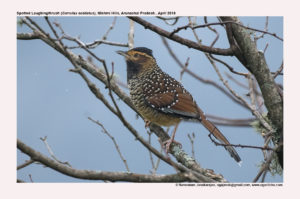Spotted Laughingthrush

Spotted Laughingthrush Garrulax ocellatus
Etymology:
- Garrulax : Latin word garrulous –babbling, chattering; ax – inclining towards
- Ocellatus: Latin word for “Marked with eyelets” derived from ocelluseyelet
Vernacular Names: Pahari: Moonalibhiakora, Lepcha: Lho-karreum-pho,
Distribution in India: Resident Himalayas in India.
Description: Size of 24–26 cm; Wt. of 52–85 g. It is a fairly large, dark brownish laughingthrush, scaled above and streaked below pale grey, with blackish-brown head and short rounded white submoustachial patch. The nominate race has dark brown crown, paler on nape, and rufescent mid-brown on mantle, shading to rufescent olive on upperparts with vague grey subterminal smudges and neat narrow dark scale-shaped tips. The rump and uppertail-coverts are dull pale chestnut; primary coverts are black, flight-feathers are fringed pale grey with broad golden-olive wing flash, tail is dull golden-olive basally, grey distally. The side of face, supercilium and rear lateral crownstripe, lores, cheek and ear-coverts are blackish, with white vertical patch behind ear-coverts and bolder creamy-white drop-shaped upper submoustachial and malar patch. The chin is blackish, throat to lower submoustachial area and breast have a brownish-tan with buffier centres and greyish edgescreating indistinct streaks. It has shading on belly, flanks and vent as buffy olive; iris is brown or olive-khaki; bill is horn-black; legs are pinkish-brown or horn-brown. Both the sexes are similar. The juvenile is browner-crowned than adult, with no white neck patch, and more uniform brown body plumage.
Habitat: It is found in undergrowth, in high-elevation forest, light open mixed forest with undergrowth, thick rhododendron scrub and bushes bordering fields. It is found from 2135m–3660 m in breeding and in winter down to 1100 m.
Food habits: It eats Insects, fruit and seeds. It is inconspicuous. It keeps in pairs and in small family parties and associates with Black-faced Laughingthrush. It forages on ground and in bushes.
Breeding habits: They breed in May–Jun in India and South China. The nest is reportedly a large, loose cup, made of twigs, dry grasses, bamboo leaves, roots, moss and ferns, lined with rootlets, placed on ground in bush, small tree or clump of ferns and grass. They lay a clutch of 2 eggs.